User Guide
Tutorly is a desktop app designed for private tutors to manage their student and lesson records efficiently. It combines the speed and precision of typing commands with the convenience of a visual interface. If you prefer using your keyboard over clicking through menus, Tutorly allows you to complete student management tasks more quickly than traditional apps.
Table of Contents
- Table of Contents
- Quick start
-
Features
- Parameter Summary
- General Commands
- Viewing tabs
-
Student Management:
student ACTION -
Session Management:
session ACTION- Adding a session:
add - Listing all sessions:
list - Viewing attendance for a session:
view - Editing a session:
edit - Searching for sessions:
search - Deleting a session:
delete - Enrolling a student to a session:
enrol - Unenrolling a student from a session:
unenrol - Marking attendance:
mark - Unmarking attendance:
unmark - Adding or updating feedback:
feedback
- Adding a session:
- Saving the data
- Editing the data file
- FAQ
- Known issues
- Command summary
- Glossary
- Coming soon
Quick start
-
Install Java: Ensure you have Java
17or above installed in your Computer. You can download the correct JDK for your operating system using this link.
Mac users: Ensure you have the precise JDK version prescribed here. -
Move the file: Locate the downloaded
tutorly.jarfile and place it in a folder where you want to keep the app’s data. This will be the app’s home folder. -
Open a command terminal - This is a tool that lets you run commands on your computer:
- On Windows: Press
Win + R, typecmd, and press Enter. - On Mac: Open Terminal from the Applications > Utilities folder.
- On Linux: Open Terminal from your applications menu.
- On Windows: Press
-
Navigate to the folder: In the terminal, type
cd(with a space after). Then, click and hold the home folder, drag it into the terminal window and release it. Doing this will automatically insert the full path of the folder. Press Enter. -
Run Tutorly: Type
java -jar tutorly.jarand press Enter. This will start the application. A GUI similar to the below should appear in a few seconds, containing some sample data.
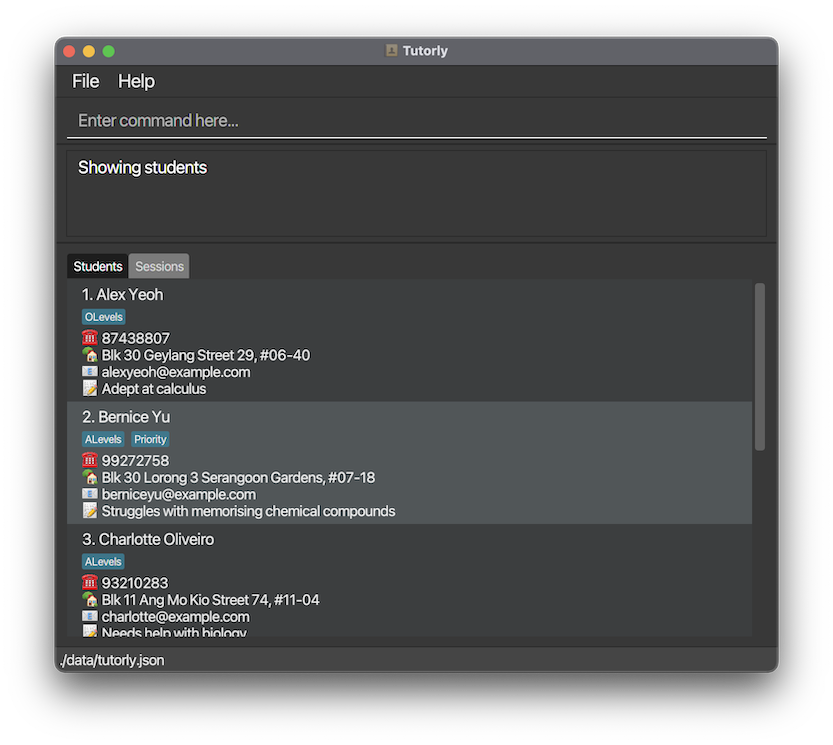
- UI Layout: Feel free to take a look at the following images for a better understanding of the layout!
Students Tab
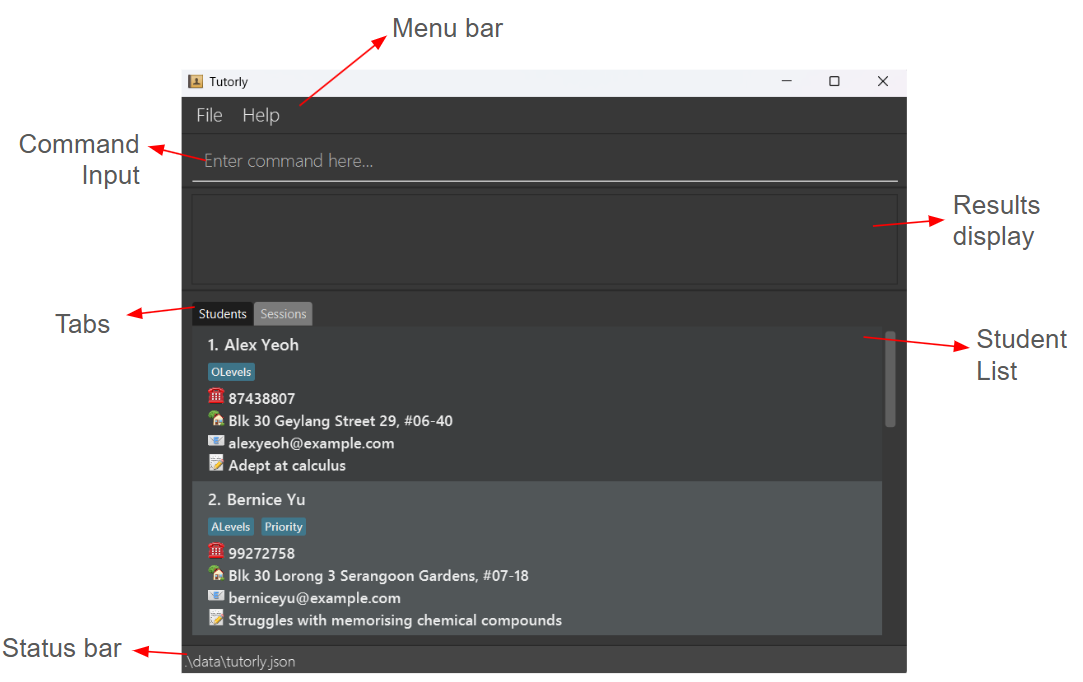
Student Card

Sessions Tab
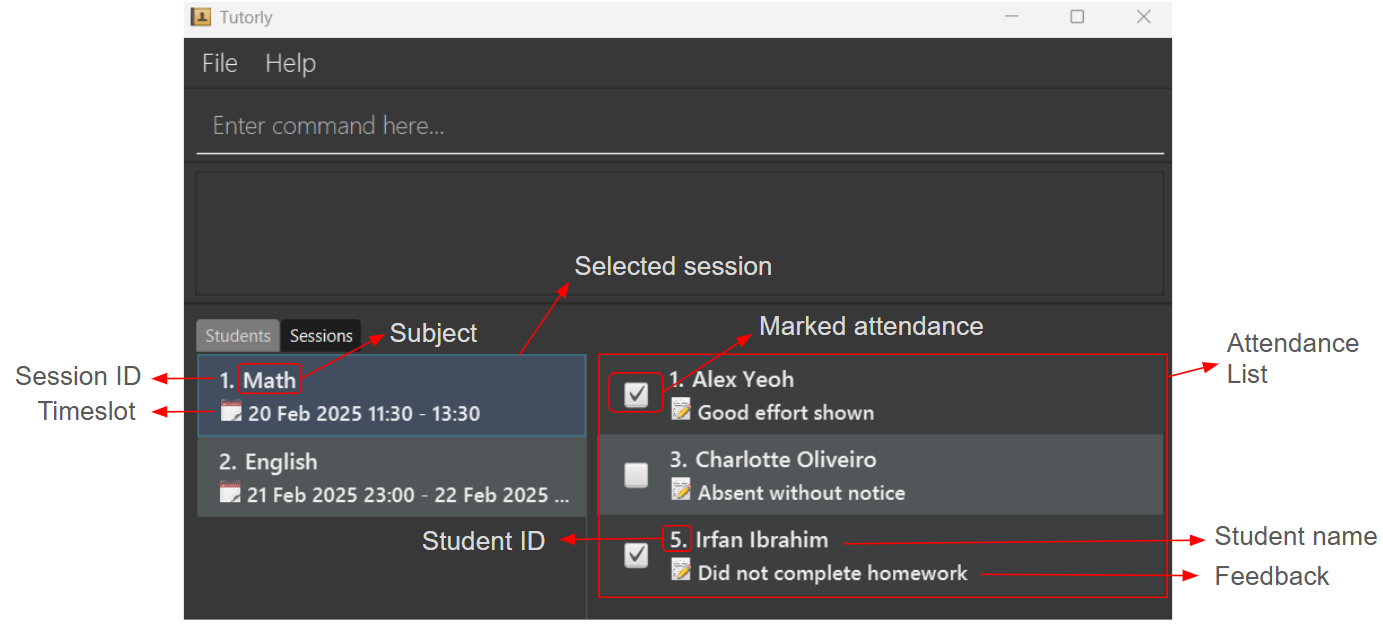
Execute a command
Type the command in the command box and press Enter to execute it. e.g. typing help and pressing Enter will open the help window.
Some example commands you can try:
-
student list: Lists all students. -
student add n/John Doe p/98765432 e/johnd@example.com a/John street, block 123, #01-01: Adds a student namedJohn Doeto the app. -
student delete 3: Deletes the student with the ID 3. -
session list: List all sessions. -
clear: Deletes all students and sessions. -
exit: Exits the app.
Refer to the Features below for details of each command.
Features
![]() Notes about the command format:
Notes about the command format:
-
Words in
UPPER_CASEare the parameters to be supplied by the user.
e.g. instudent add n/NAME,NAMEis a parameter which can be used asstudent add n/John Doe. -
STUDENT_IDENTIFIER can either be the target student’s ID, or their full name. Examples:
John Doeor2. -
Parameters in square brackets are optional.
e.gn/NAME [t/TAG]can be used asn/John Doe t/friendor asn/John Doe. -
Items with
… after them can be used multiple times including zero times.
e.g.[t/TAG]…can be used ast/friend,t/friend t/familyetc. -
Parameters can be in any order.
e.g. if the command specifiesn/NAME p/PHONE,p/PHONE n/NAMEis also acceptable. -
Extra parameters for commands that do not take in parameters (general commands,
student listandsession list) will be ignored.
e.g. if the command specifieshelp 123orsession list blah, it will be interpreted ashelpandsession list. -
If you are using a PDF version of this document, be careful when copying and pasting commands that span multiple lines as space characters surrounding line-breaks may be omitted when copied over to the application.
Parameter Summary
| Parameter | Format | Constraint | Length | Example |
|---|---|---|---|---|
| ADDRESS | - | - | Max: 255 | Blk 30 Geylang Street 29, #06-40 |
| DATE | dd MMM yyyy |
- | - | 11 Apr 2025 |
local-part@domain |
- | Max: 254 | hello@tutorly.com | |
| FEEDBACK | - | - | Max: 200 | Did not complete homework |
| MEMO | - | - | Max: 255 | Adept at calculus |
| NAME | - | Start with a letter, and only contain letters, numbers, spaces, and these special characters: ()@*-+=:;'<>,?/.
|
Max: 255 | John Doe |
| PHONE | - | Only contain numbers, spaces, hyphens, and an optional country code prefix | Min: 3 Max: 20 |
+65 98765432 |
| SUBJECT | - | - | Max: 20 | Mathematics |
| TAG | - | - | Max: 20 | A-Levels |
| TIMESLOT |
dd MMM yyyy HH:mm-HH:mm for sessions within a day,dd MMM yyyy HH:mm-dd MMM yyyy HH:mm for sessions spanning multiple days |
- | - | 11 Apr 2025 16:00-18:00 |
General Commands
Viewing help: help
Shows a window containing the command summary with a link to this user guide.
Format: help
Help window:
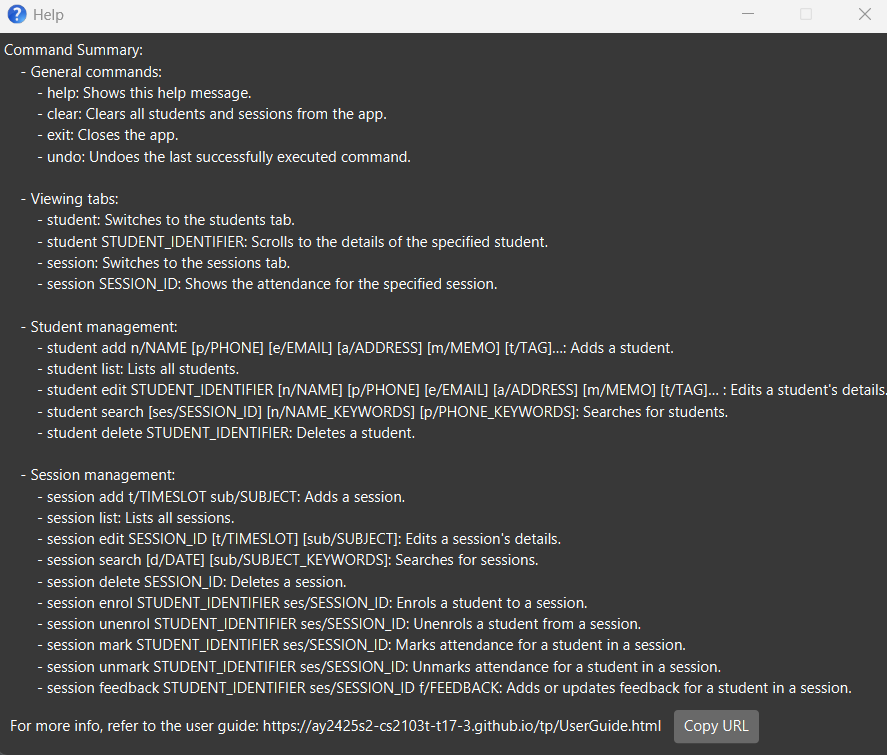
Clearing all data: clear
Clears all students and sessions from the app.
Format: clear
Example output:
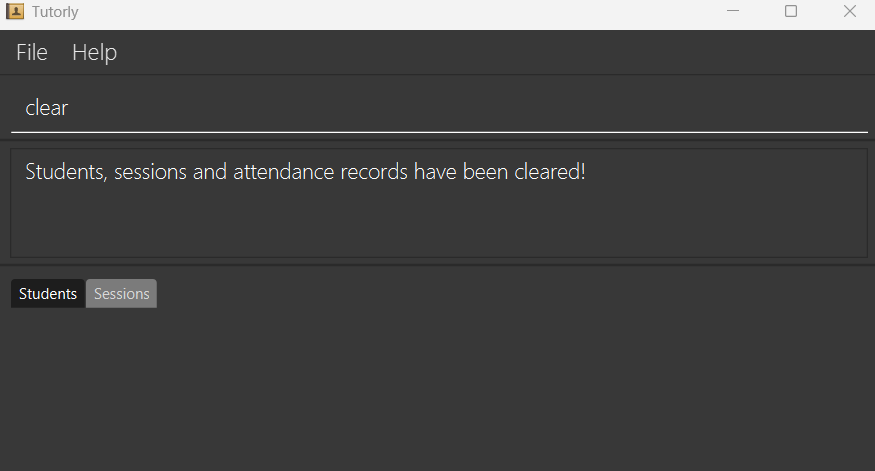
Running the undo command after clear restores all students and sessions to before the command was run.
Exiting the program: exit
Closes the Tutorly app.
Format: exit
Undoing a command: undo
Undoes the last successfully executed command that has updated the data.
Commands that update data and are thus undoable:
- The
clearcommand. - The
add,deleteandeditcommands for student and session. - The
enrol,unenrol,mark,unmarkandfeedbackcommands for session.
Format: undo
Examples:
-
session deletefollowed byundowill undo the delete command by adding the session back. - If the following commands were ran in order:
student edit,student add,student search,help, runningundowill undo thestudent addcommand.
undo will not undo any previous commands before the app was closed.
Viewing tabs
search will also clear any filters from previous search commands.
Viewing students tab: student
Shows the student tab in the main window.
Format: student
Viewing sessions tab: session
Shows the session tab in the main window.
Format: session
Student Management: student ACTION
The following commands all begin with student followed by an action word.
Adding a student: add
Adds a student to the app.
Format: student add n/NAME [p/PHONE] [e/EMAIL] [a/ADDRESS] [m/MEMO] [t/TAG]…
- Refer to the parameter summary for the expected formats of the parameters.
Examples:
student add n/John Doe p/98765432 e/johnd@example.com a/John street, block 123, #01-01 m/loves Mathstudent add n/Mary Jane t/olevels e/maryjane@example.com p/81234567 t/priority
student add n/Mary Jane when a student with the name Mary Jane already exists will show an error as it is considered a duplicate student.
Example output:
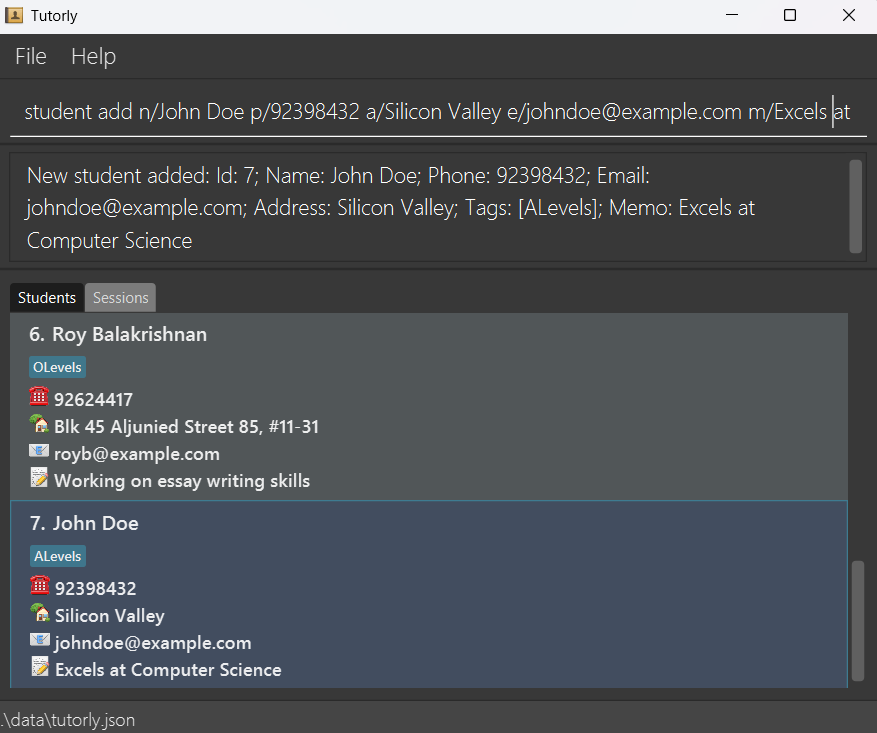
Running the undo command after student add removes the newly added student.
Listing all students: list
Shows a list of all students.
Format: student list
Viewing student card: view
Scrolls to the details of the student with the specified STUDENT_IDENTIFIER in the window of the student tab.
Format: student view STUDENT_IDENTIFIER
Examples:
student view 1student view John Doe
Example output:
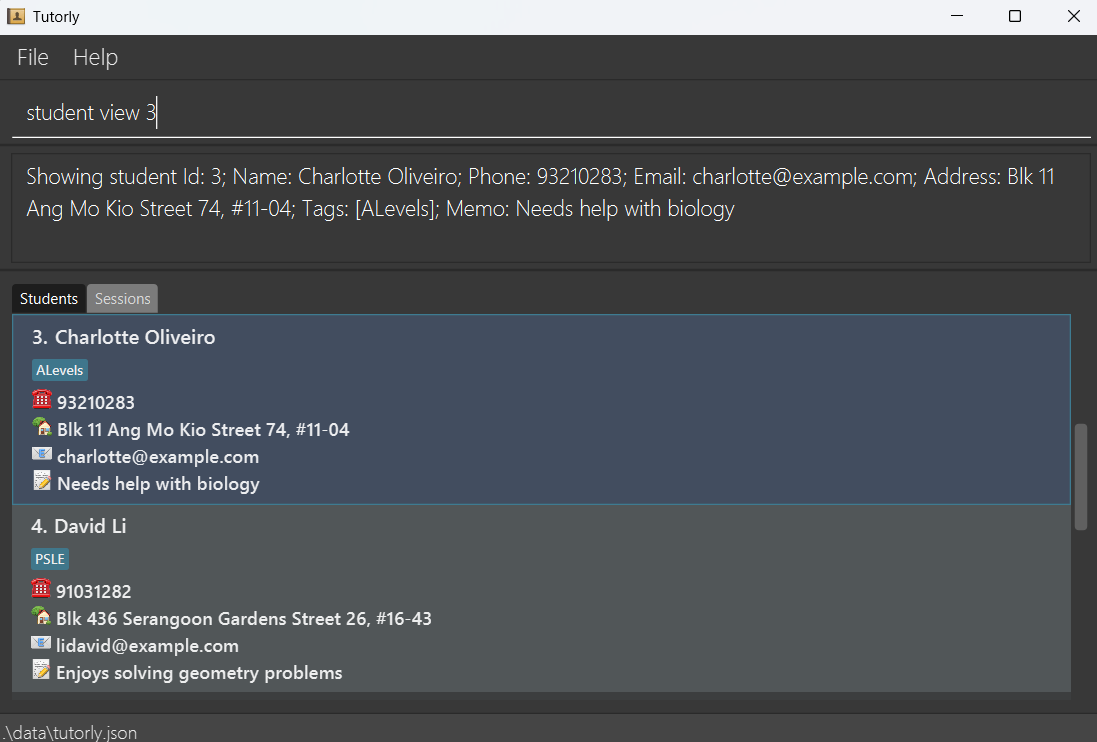
Editing a student: edit
Edits an existing student with the specified STUDENT_IDENTIFIER.
Format: student edit STUDENT_IDENTIFIER [n/NAME] [p/PHONE] [e/EMAIL] [a/ADDRESS] [m/MEMO] [t/TAG]…
- At least one of the optional parameters must be provided.
- Existing values will be updated to the input values.
- When editing tags, the existing tags of the student will be removed i.e adding of tags is not cumulative.
- You can remove all the student’s tags by typing
t/without specifying any tags after it.
Examples:
-
student edit John Doe p/91234567 e/johndoe@example.comEdits the phone number and email address of John Doe to be91234567andjohndoe@example.comrespectively. -
student edit 2 n/Betsy Crower t/Edits the name of the student with an ID of 2 to beBetsy Crowerand clears all existing tags.
student edit 3 n/Betsy Crower when another student named Betsy Crower already exists will show an error as it is considered a duplicate student.
Example output:
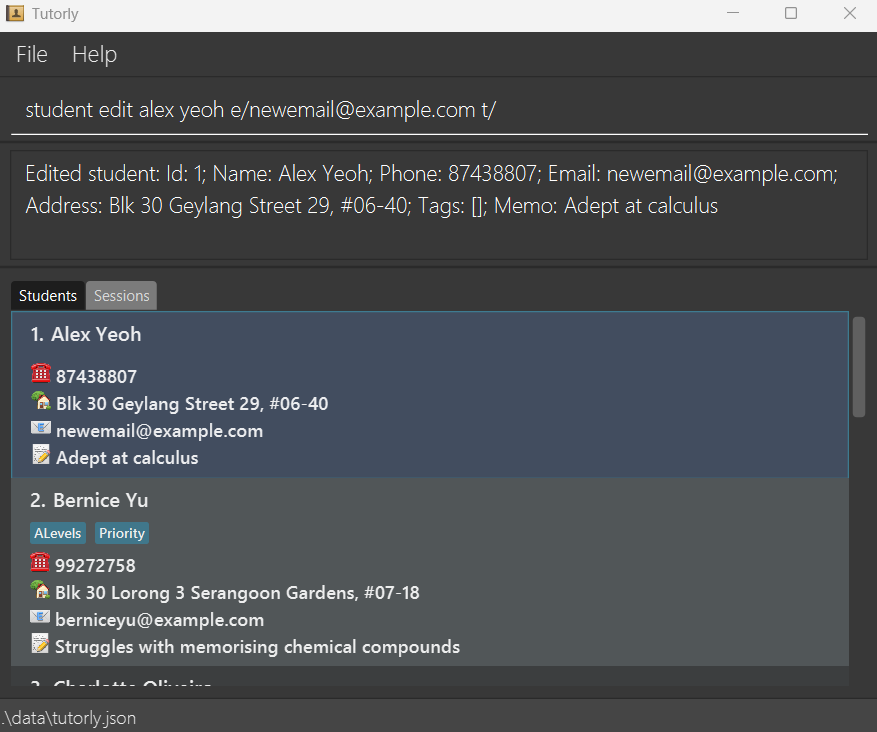
Running the undo command after student edit reverts the student’s details back to before the edit was made.
Searching for students: search
Finds students whose names or phone numbers contain any of the given keywords, or is enrolled to a specific session.
Format: student search [ses/SESSION_ID] [n/NAME_KEYWORDS] [p/PHONE_KEYWORDS]
- The keywords are case-insensitive and order does not matter. e.g.
hans bowill matchBo Hans - Incomplete words will still be matched e.g.
Hanwill matchHansor8765will match91238765 - Students matching at least one keyword or are enrolled to the session will be returned.
SESSION_ID only accepts one valid positive number that corresponds with an existing session’s ID.
This will be updated in future versions to allow the searching of multiple IDs.
Examples:
-
student search n/John p/9123 8765returnsjohnathan,John Doeand other students with a phone number that contains9123or8765. -
student search ses/3 n/alex davidreturnsAlex Yeoh,David Liand other students who attended session with the id 3. -
student searchwill simply return all students.
Example output (with matching keywords highlighted):
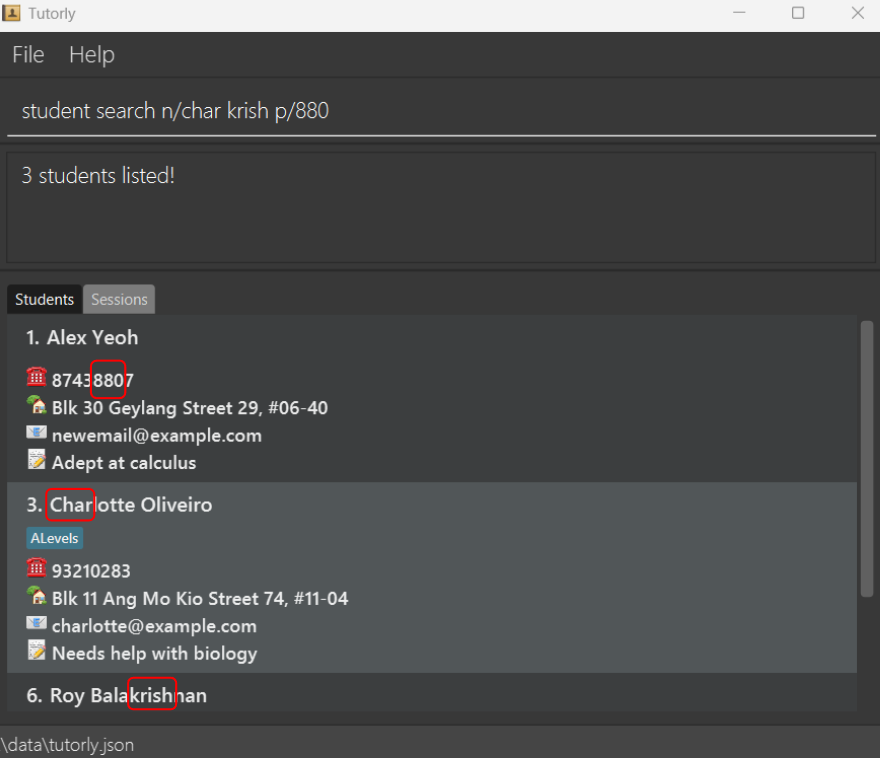
Deleting a student: delete
Deletes the student with the specified STUDENT_IDENTIFIER.
Format: student delete STUDENT_IDENTIFIER
Examples:
-
student delete 2deletes the student with the ID of 2. -
student delete John Doedeletes the student with the nameJohn Doe.
Running the undo command after student delete adds the deleted student back.
Session Management: session ACTION
The following commands all begin with session followed by an action word.
Adding a session: add
Adds a session to the app.
Format: session add t/TIMESLOT sub/SUBJECT
- Refer to the parameter summary for the expected format of
TIMESLOTandSUBJECT.
Examples:
-
session add t/30 Mar 2025 11:30-13:30 sub/Mathadds a session with the subjectMathon 30 March 2025 from 11.30am to 13.30pm. -
session add t/30 Mar 2025 23:00-31 Mar 2025 01:00 sub/Engadds a session with the subjectEngwhich lasts 2 hours from 30 March 2025 11pm to 31 March 2025 1am.
Running the undo command after session add removes the newly added session.
Example output:
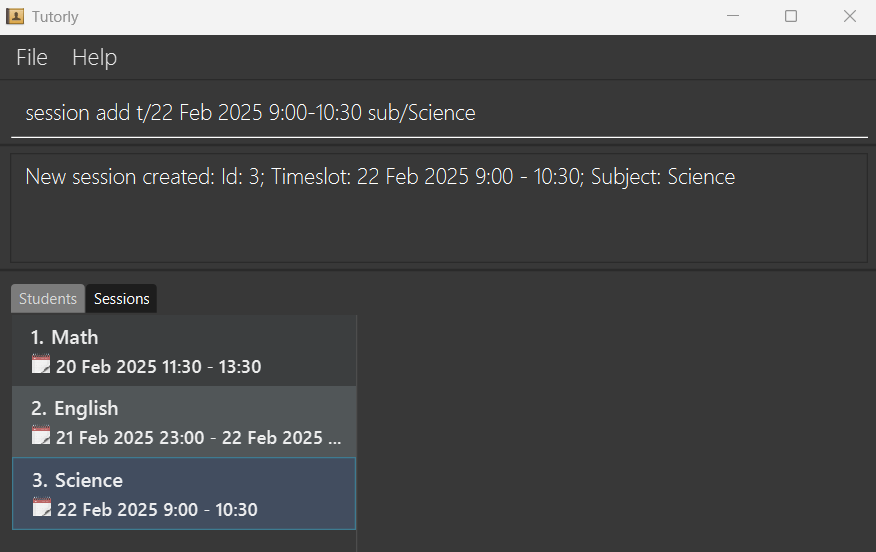
Listing all sessions: list
Shows a list of all sessions.
Format: session list
Viewing attendance for a session: view
Shows the attendance of students for a given session.
Format: session view SESSION_ID
Examples:
session view 1session view 5
Example Output:
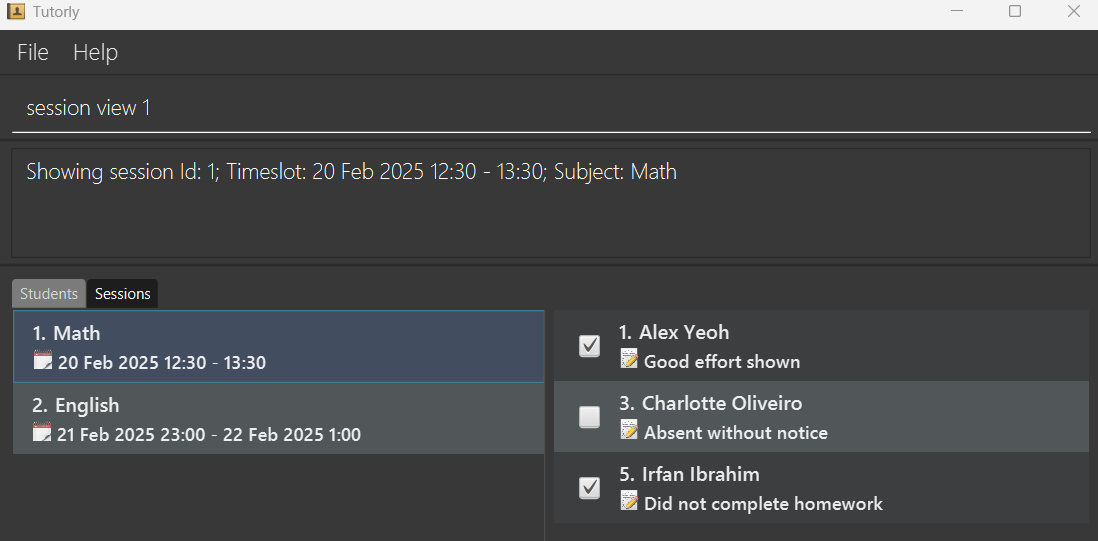
Editing a session: edit
Edits an existing session with the specified SESSION_ID.
Format: session edit SESSION_ID [t/TIMESLOT] [sub/SUBJECT]
- At least one of the optional parameters must be provided.
- Existing values will be updated to the input values.
Examples:
-
session edit 3 t/11 Apr 2025 11:30-13:30Edits the date of the session with the ID 3 to be on 11 April 2025 from 11.30am to 1.30pm. -
session edit 2 t/20 June 2025 23:00-21 June 2025 01:00 sub/MathEdits the date and subject of the session with the ID 2 to last from 20 June 2025 11pm to 21 June 2025 1am with the subjectMath.
Running the undo command after session edit reverts the session’s details back to before the edit was made.
Searching for sessions: search
Finds sessions on a particular date or on a subject which matches any of the given keywords.
Format: session search [d/DATE] [sub/SUBJECT_KEYWORDS]
- Refer to the parameter summary for the expected format of
DATE. - The keywords are case-insensitive and order does not matter. e.g.
math engwill matchEng Math - Incomplete words will still be matched e.g.
Matwill matchMath - Sessions whose timeslots contain the given date or have a subject that match at least one keyword will be returned.
Examples:
-
session search d/22 May 2025returns sessions with timeslots that include 22 May 2025. -
session search sub/Math d/11 Jun 2025returns sessions with subjectsMath,Mathematicsand sessions with timeslots that include 11 June 2025. -
session searchwill simply return all sessions.
Example output (with matching keywords and date highlighted):
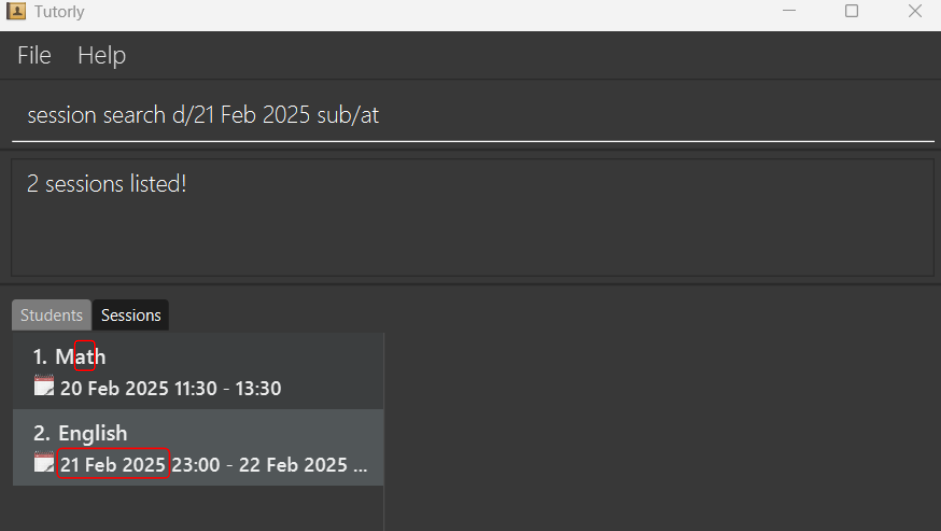
Deleting a session: delete
Deletes the session with the specified SESSION_ID.
Format: session delete SESSION_ID
Examples:
-
session delete 2deletes the session with the ID of 2.
Running the undo command after session delete adds the deleted session back.
Enrolling a student to a session: enrol
Enrols a student with the specified STUDENT_IDENTIFIER to a specific session.
Format: session enrol STUDENT_IDENTIFIER ses/SESSION_ID
- The attendance for the student to the session upon enrolment is marked as absent by default.
Examples:
-
session enrol 2 ses/3enrols a student with an ID of 2 to attend a session with an ID of 3. -
session enrol John Doe ses/4enrols a student with the nameJohn Doeto attend a session with an ID of 4.
Example output:
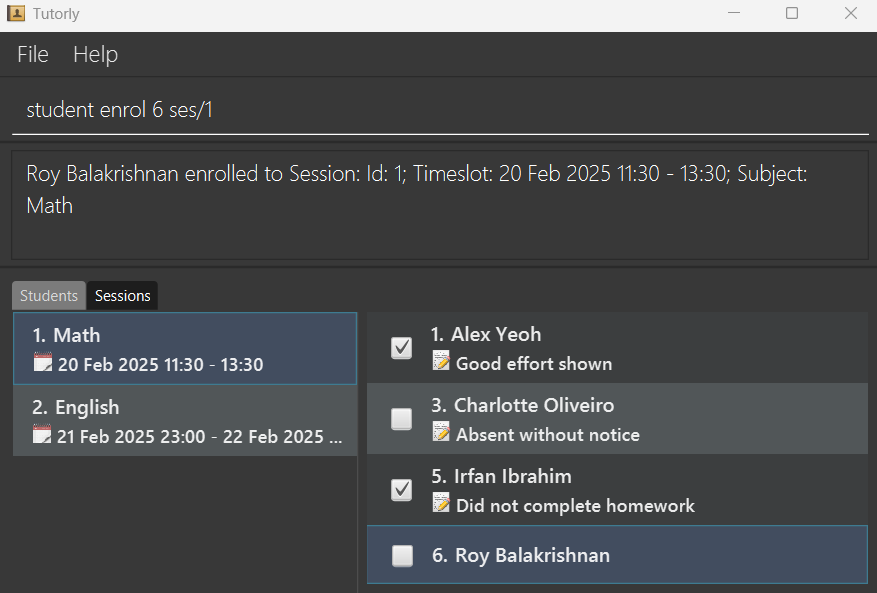
Running the undo command after session enrol will unenrol the student from the session.
Unenrolling a student from a session: unenrol
Unenrols a student with the specified STUDENT_IDENTIFIER from a session.
Format: session unenrol STUDENT_IDENTIFIER ses/SESSION_ID
Examples:
-
session unenrol 2 ses/3unenrols a student with an ID of 2 from a session with an ID of 3. -
session unenrol John Doe ses/4unenrols a student with the nameJohn Doefrom a session with an ID of 4.
Running the undo command after session unenrol will enrol the student back into the session.
Marking attendance: mark
Marks the attendance of a student with the specified STUDENT_IDENTIFIER for a session.
Format: session mark STUDENT_IDENTIFIER ses/SESSION_ID
- Note that only students who are enrolled in the session can be marked as present.
Examples:
-
session mark 2 ses/3marks the attendance for the student with an ID of 2 for a session with an ID of 3 as present. -
session mark John Doe ses/4marks the attendance for a student with the nameJohn Doefor a session with an ID of 4 as present.
Running the undo command after session mark will unmark the student’s attendance in the session.
Unmarking attendance: unmark
Unmarks the attendance of a student with the specified STUDENT_IDENTIFIER for a session.
Format: session unmark STUDENT_IDENTIFIER ses/SESSION_ID
- Note that only students who are enrolled in the session can be unmarked.
Examples:
-
session unmark 2 ses/3unmarks the attendance for the student with an ID of 2 for a session with an ID of 3. -
session unmark John Doe ses/4unmarks the attendance for a student with the nameJohn Doefor a session with an ID of 4.
Running the undo command after session unmark will mark the student’s attendance in the session.
Adding or updating feedback: feedback
Adds or updates the feedback for a student with the specified STUDENT_IDENTIFIER in a session.
Format: session feedback STUDENT_IDENTIFIER ses/SESSION_ID f/FEEDBACK
- Refer to the parameter summary for the expected format of
FEEDBACK. - If no feedback exists, a new feedback will be added for the student in the session.
- If a feedback already exists, the old feedback will be overwritten, i.e. Only one feedback is allowed per student per session.
- You can remove a previously set feedback by typing f/ without specifying any feedback after it.
- Feedback for a student is viewable in the attendance list of a session.
Examples:
-
session feedback 2 ses/3 f/Good Job!updates the feedbackGood Job!for the student with an ID of 2 for a session with an ID of 3. -
session feedback John Doe ses/4 f/Sick leaveupdates the feedbackSick leavefor a student with the nameJohn Doefor a session with an ID of 4. -
session feedback Betsy Crower ses/4 f/clears the feedback for a student with the nameBetsy Crowerfor a session with an ID of 4.
Example output:
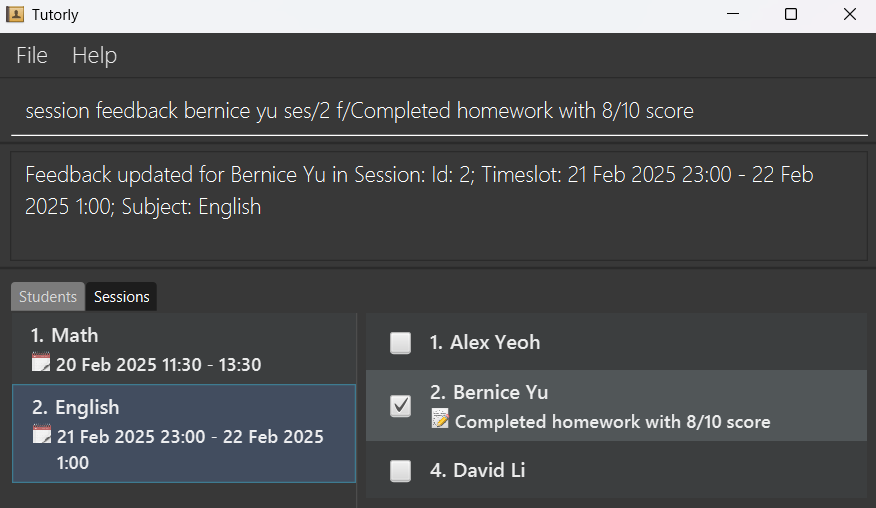
Running the undo command after session feedback reverts the feedback back to before the command was run.
Saving the data
Tutorly data are saved in the hard disk automatically after any command that changes the data. There is no need to save manually.
Editing the data file
Tutorly data are saved automatically as a JSON file [home_folder]/data/tutorly.json. Advanced users are welcome to update data directly by editing that data file.
Furthermore, certain edits can cause the Tutorly to behave in unexpected ways (e.g., if a value entered is outside of the acceptable range). Therefore, edit the data file only if you are confident that you can update it correctly.
FAQ
Q: How do I transfer my data to another Computer?
A: Install the app in the other computer and overwrite the empty data file it creates with the file that contains the data of your previous Tutorly home folder.
Q: What is the difference between the student list and student commands?
A: The student list command will list all students in Tutorly. The student command simply switches the active tab to students and preserves results from any previous student search commands. The same applies to session and session list.
Q: What is the difference between the memo and feedback?
A: Memo is a short note you can add on to a student’s details, while feedback is specifically for a student’s performance in a particular session.
Q: How should I fill in the STUDENT_IDENTIFIER parameter?
A: The STUDENT_IDENTIFIER can either be the student’s ID or their full name, both of which are viewable from the student tab in the app.
Known issues
-
When using multiple screens, if you move the application to a secondary screen, and later switch to using only the primary screen, the GUI will open off-screen. The remedy is to delete the
preferences.jsonfile created by the application before running the application again. -
If you minimize the Help Window and then run the
helpcommand (or use theHelpmenu, or the keyboard shortcutF1) again, the original Help Window will remain minimized, and no new Help Window will appear. The remedy is to manually restore the minimized Help Window. -
For commands that should focus on a specific item in the window, like after a
student addorsession enrol, the window may sometimes not scroll to the target item due to UI loading behaviour. The remedy is to run theviewcommand again for the window to scroll to the target item, or use the scrollbar in the tab.
Command summary
| Context | Action | Format | Examples |
|---|---|---|---|
| General | Help | help |
- |
| Clear data | clear |
- | |
| Exit | exit |
- | |
| Undo command | undo |
- | |
| Tab | Show students tab | student |
- |
| Show session tab | session |
- | |
| Student | Add | student add n/NAME [p/PHONE] [e/EMAIL] [a/ADDRESS] [m/MEMO] [t/TAG]… |
student add n/John Doe p/98765432 |
| List | student list |
- | |
| View card | student view STUDENT_IDENTIFIER |
student view 1 or student view John Doe
|
|
| Edit | student edit STUDENT_IDENTIFIER [n/NAME] [p/PHONE] [e/EMAIL] [a/ADDRESS] [m/MEMO] [t/TAG]… |
student edit 2 n/James Lee p/91234567 |
|
| Search | student search [ses/SESSION_ID] [n/NAME_KEYWORDS] [p/PHONE_KEYWORDS] |
student search n/alex dav p/9123 8765 |
|
| Delete | student delete STUDENT_IDENTIFIER |
student delete 3 |
|
| Session | Add | session add t/TIMESLOT sub/SUBJECT |
session add t/30 Mar 2025 11:30-13:30 sub/Math |
| List | session list |
- | |
| View attendance | session view SESSION_ID |
session view 4 |
|
| Edit | session edit SESSION_ID [t/TIMESLOT] [sub/SUBJECT] |
session edit 2 t/11 Jun 2025 11:30-13:30 sub/English |
|
| Search | session search [d/DATE] [sub/SUBJECT_KEYWORDS] |
session search d/2025-04-15 sub/Math Eng |
|
| Delete | session delete SESSION_ID |
session delete 1 |
|
| Enrol student | session enrol STUDENT_IDENTIFIER ses/SESSION_ID |
session enrol 4 ses/3 |
|
| Unenrol student | session unenrol STUDENT_IDENTIFIER ses/SESSION_ID |
session unenrol 4 ses/3 |
|
| Mark attendance | session mark STUDENT_IDENTIFIER ses/SESSION_ID |
session mark John Doe ses/2 |
|
| Unmark attendance | session unmark STUDENT_IDENTIFIER ses/SESSION_ID |
session unmark 3 ses/2 |
|
| Add or Update feedback | session feedback STUDENT_IDENTIFIER ses/SESSION_ID f/FEEDBACK |
session feedback 3 ses/2 f/Good Job! |
Glossary
| Term | Definition |
|---|---|
| Command Terminal | A tool on a computer where you type instructions to make the computer perform tasks. |
| Home folder | The folder which contains the tutorly.jar file and data folder. |
| JAR | Java Archive file: A package that bundles a Java program and all its necessary parts into a single file, making it easier to share and run. |
| JDK | Java Development Kit: A software package that provides everything needed to create and run Java programs. |
| Operating System | An operating system is the main software that manages a computer’s hardware and allows you to run applications. Some examples include Windows, Mac and Linux. |
| Parameters | These are placeholders in a command that users replace with specific information to customize the command’s action. They are usually prefixed with letters like n/ or p/. |
| STUDENT_IDENTIFIER | A parameter used to identify a student. It can either be the student’s ID (a positive number), or their full name. |
Coming soon
Planned features that will be added in the coming versions.
- A
redocommand in case you want to undo yourundo. - Improved
searchcommand forstudentandsessionwith other fields including tags and date/time range with control over matching any or all fields. -
classmanagement commands that handles adding of multiple sessions and mass enrolling/marking of attendance for students. - Viewing sessions each student is enrolled in via the
studentstab. - Add support for multiple students of the same name.
- Better auto scroll and focus on target item being updated in window.
- Seamlessly present long messages without requiring scrolling.